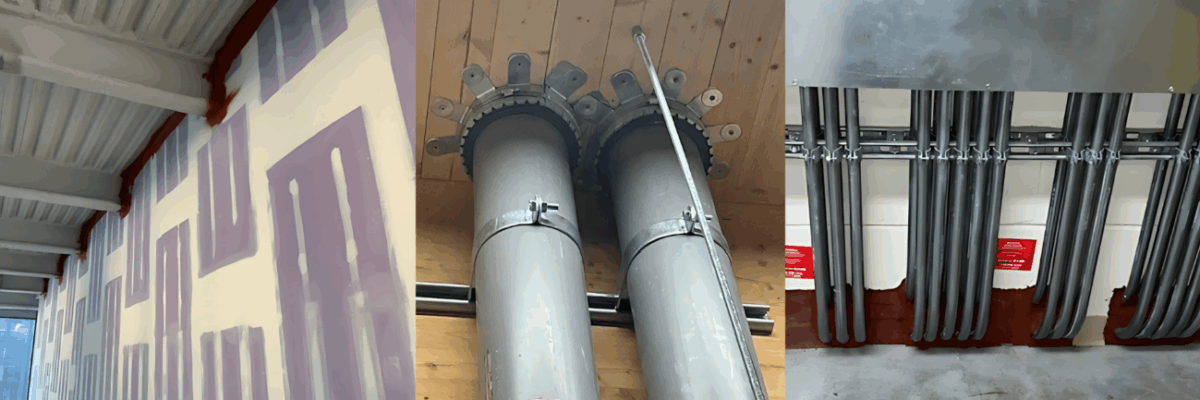In the field of fire protection, codes and standards are crucial. They create a framework for life safety, consistency, and compliance. But what happens when a real-world situation doesn’t fit perfectly into the codebook? That’s where engineering judgments (EJ) come into play—and where NV5 offers clarity and confidence.
What is an Engineering Judgment?
An engineering judgment is a professional opinion rendered by a qualified engineer when existing codes or tested systems don’t explicitly address a specific condition. It’s not a shortcut, it’s a rigorously considered decision based on experience, technical knowledge, and a deep understanding of fire protection principles.
As Patrick Tesche, Vice President – Fire Protection Group, explained in our recent conversation, “An EJ is about applying what we know from tested and listed systems to a new situation that hasn’t been tested yet, but still needs a safe, code-compliant solution.”
EJs are typically issued as letters or reports that evaluate site-specific applications deviating from traditional tested and listed systems. Their value lies in their ability to address the unique characteristics of each assembly and penetration—something standardized systems can’t always do.
Why are Engineering Judgments Necessary?
Buildings are complex. Renovations, retrofits, and unique architectural features often create conditions that fall outside the scope of standardized listed firestop systems. In these cases, testing a system isn’t practical or cost-effective. EJs allow engineers to bridge the gap between code and context. They ensure that life safety isn’t compromised, even when the path forward isn’t clearly defined. They’re especially critical in high-stakes environments like hospitals, data centers, high-rise commercial projects, multi-family complexes, educational institutions, and mission-critical facilities where downtime or design delays are not an option.
What Sets NV5 Apart
At NV5, we don’t just conduct 3rd party reviews of manufacturers’ engineering judgments, we also design and develop alternate means and methods that we stand behind. Our team has decades of experience in fire protection engineering, and we approach every EJ with a commitment to clarity, documentation, and defensibility.
How NV5 Approaches Engineering Judgments
At NV5, our process for developing engineering judgments is grounded in technical rigor, ethical standards, and responsiveness to project needs. Here’s how we approach it:
- Timely Delivery: Recognizing the importance of keeping projects on schedule without compromising quality, we typically complete engineering judgments within 48 to 72 hours. “Our turnaround is fast, but we don’t cut corners. We do it right,” Pat noted.
- Standards-Based Practice: Each EJ is supported by a formal engineering analysis that references relevant manufacturer data. We only sign and seal documents that we’ve directly authored and overseen, in accordance with professional engineering standards.
- Cost-Conscious Mindset: Our pricing is designed to make EJs accessible across a range of project types and budgets, helping ensure that safety and compliance remain achievable goals. “I priced our services so people wouldn’t shy away from doing it the right way. Life Safety shouldn’t be cost-prohibitive,” Pat shared.
- Industry Experience: Our team includes professionals with backgrounds in firestop manufacturing, field application, and active committee members of ASTM E06 (Serviceability), ASTM E05 (Fire Test), and the UL Standard Technical Panel 1479/2079, giving us a practical understanding of how to apply code requirements in real-world conditions.
NV5 also supports clients in navigating complex project conditions, especially when multiple manufacturers are involved. While Manufacturers may offer EJs at no cost, their scope is often limited. NV5 provides a more comprehensive service, including consulting and conflict resolution when systems overlap.
The Evolving Role of Engineering Judgments
As jurisdictions adopt more stringent requirements, the role of engineering judgments is expanding. Increasingly, authorities having jurisdiction (AHJs) are requiring third-party reviews, signed and sealed EJs, and formal firestop inspections as per ASTM E2174 “Standard Practice for Inspection of Installed Firestops” and ASTM E2393 “Standard Practice for Inspection of Fire-Resistive Joints and Perimeter Fire Barrier”. This shift underscores the growing importance of qualified engineering input in fire protection design. Our team is experienced with the requirements across North America, especially in jurisdictions like Clark County, NV (Las Vegas), Mecklenburg County, NC (Charlotte), and agencies like the Illinois Department of Public Health and the California State Fire Marshal’s Office.
Final Thoughts
Engineering judgments are a vital part of modern fire protection. They require technical expertise, professional integrity, and a deep understanding of both the letter and the spirit of the code. As new materials and construction methods evolve, the need for expert evaluation and judgment becomes even more critical. At NV5, we bring all three to every Alternative Firestop Design we issue—because when it comes to life safety, there’s no room for guesswork.

